
You just bought your first gun—or are considering getting one—and need to learn how to use it. Sound familiar? We’ve all been there. It’s normal, just like the first time you sat behind the wheel of a car as a teenager as Mom or Dad tried to teach you how to drive. It was a hair-raising experience, and you had absolutely no idea what to do. Now you’ve purchased your first firearm and need to learn how to use it safely and effectively, so you signed up for a basic pistol class. Kudos: You chose wisely and are off to a great start.
Taking a basic pistol class can be an exciting and empowering experience. Whether you're a first-time gun owner or looking to refresh your skills, proper preparation ensures a safe and successful learning experience. Let’s look at how to prepare for a basic pistol class, covering everything from the essential gear you should bring to the right attitude for a productive learning environment.

The Importance of Training
Before diving into the preparation details, it's essential to understand why training is crucial when it comes to firearms, which are powerful tools that demand respect and responsible use. A basic pistol class is an opportunity to gain valuable knowledge and skills to enhance firearm safety, confidence, and proficiency. Regardless of your previous experience, training helps build a solid foundation and reinforces essential safety practices.
As an NRA-certified instructor, I always remind students—both beginning and advanced—that they can’t train enough. Keep training. Never stop. You will never be perfect, and there is always room for improvement.
Gear and Equipment
- Firearm: Depending on the class, you may be required to bring your own firearm, while others will let you borrow one. Be sure you know before you get there. If you bring your own gun, ensure that it is in proper working condition, clean, and well-maintained. It's a good idea to familiarize yourself with your firearm's manual and operation before the class.
- Ammunition: Check the course requirements for the specific type and quantity of ammunition you'll need. Bring enough for the entire class, plus a little extra in case of unexpected delays or additional practice time.
- Eye and Ear Protection: Safety should always come first. Bring quality eye protection (safety glasses or goggles) and ear protection (earplugs or earmuffs). These items are essential to protect your senses from the loud noise and potential debris associated with firing a pistol.
- Holster and Belt: If required by the class, bring a holster that is suitable for your firearm. Make sure it securely retains the pistol and covers the trigger guard to prevent accidental discharges. A sturdy belt is also essential to properly support the holster.
- Magazine Pouches: If your class involves reloading drills, magazine pouches will be handy. They keep spare magazines within easy reach during training exercises. Most basic pistol classes will not get this complicated, so check with your instructor ahead of time.
- Note-Taking Materials: Bring a notebook and pen to take notes during the class. Instructors often provide valuable information that you'll want to reference later.
- Appropriate Clothing: Dress comfortably and wear suitable clothing for the weather. This is important regardless of whether the range is indoors or outdoors. Some indoor ranges are kept chilly by the air system required to keep the air in good shape, so a jacket or sweatshirt is likely a good idea. Also, most instructors will not cancel class unless the weather gets hazardous, so assume the class is still on if it’s cold or rainy. Closed-toe shoes are a must for safety reasons.
- Food and Hydration: Depending on the class length, bring snacks and plenty of water to stay hydrated and maintain your energy levels.
- Required Paperwork: Bring any required documentation, such as a driver's license, concealed carry permit (if applicable), and course registration information.
The Right Attitude
 Preparing the right gear is essential, but your attitude and mindset are equally important in a firearms training class. Here's how to cultivate the right attitude:
Preparing the right gear is essential, but your attitude and mindset are equally important in a firearms training class. Here's how to cultivate the right attitude:
- Safety first: Always prioritize safety. Treat every firearm as if it is loaded, keep the muzzle pointed in a safe direction, and keep your finger off the trigger until you're ready to shoot. Listen carefully to your instructor's safety instructions and adhere to them without exception.
- Open mindset: Approach the class with an open, eager-to-learn mindset. Be receptive to new ideas and techniques, even if they challenge your existing knowledge. Remember, you chose to attend the class because you are learning, not because you already know it all.
- Respect for others: Respect your fellow participants and instructors. Everyone is there to learn, so be supportive and courteous. Avoid discussing divisive topics unrelated to the class.
- Be coachable: Listen to your instructors and be willing to accept constructive criticism. They are not there to poke fun at you but to make you better. Learning is a continuous process, and feedback from experienced instructors can greatly improve your skills.
- Patience: Firearms training can be intense, and you may face challenges along the way. Be patient with yourself and others. Remember that proficiency takes time and practice.
- Focus on fundamentals: Embrace the basics. A strong foundation in firearm safety, marksmanship, and handling is essential before advancing to more complex skills.
- Ask questions: Don't hesitate to ask questions if something is unclear or you need further clarification. Instructors are there to help you learn and ensure your safety.
- Practice responsibility: Beyond the class, carry the lessons of safety and responsibility with you. Secure your firearms when not in use and continue to improve your skills through regular practice and additional training.
Preparing for a basic pistol class involves more than just gathering the right gear. It's about adopting the right attitude and mindset that prioritize safety, learning, and responsibility. With the proper equipment and the right approach, you'll excel in your class and develop a solid foundation for a lifelong journey of responsible firearm ownership and proficiency. Remember, the key to firearm safety and proficiency is education, practice, and a commitment to continuous improvement.



































